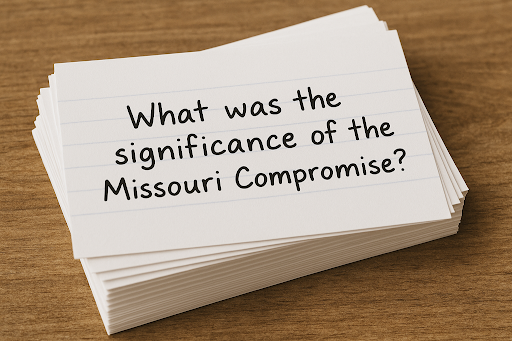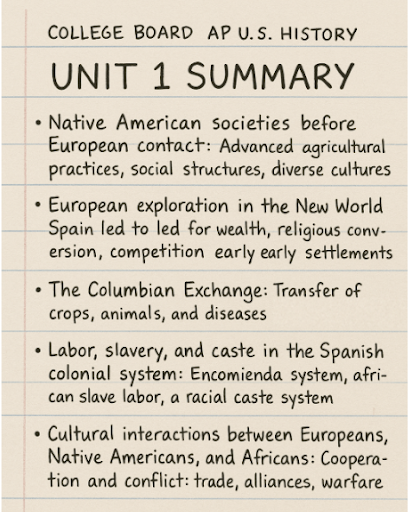Contents
Feeling overwhelmed by AP U.S. History? You're definitely not alone. With centuries of American history to master and tough exam questions to tackle, APUSH can seem pretty scary at first.
However, success in AP US History isn't about having a perfect memory or being naturally gifted at history. As an experienced History teacher, I have helped hundreds of students achieve exam success through having the right study plan and knowing exactly what the exam expects from them.
This guide will show you exactly how to study smart, not just hard. You'll learn the most effective techniques, avoid common mistakes, and build the skills you need to ace every part of the APUSH exam.
Understand the APUSH Exam Structure
Before you dive into studying, you need to know exactly what you're preparing for. The APUSH exam isn't just about memorizing dates and names. It tests your ability to think like a historian.
Types of Questions in AP US History
Multiple Choice Questions (MCQs)
55 questions in 55 minutes.
These aren't simple fact-recall questions. Most include documents, images, or charts that you need to analyze.
Short Answer Questions (SAQs)
Three questions in 40 minutes.
You'll answer specific prompts about historical periods, often using provided sources.
Document-Based Question (DBQ)
One essay question in 60 minutes (including 15 minutes for planning).
You'll analyze seven documents and write a historical argument.
Long Essay Question (LEQ)
One essay from three choices in 40 minutes.
You'll choose a prompt and write an argument using your own historical knowledge.
Score breakdown
Type of Question | Percentage of Final Score |
MCQs | 40% |
SAQs | 20% |
DBQ | 25% |
LEQ | 15% |
Question coverage
The content comes from nine chronological units covering 1491 to the present. In my experience, lots of students forget that the units within the exam are weighted, meaning that some units are worth more than others.
Units 3-8 (1754-1980) make up about 80% of your exam questions. Units 1, 2, and 9 split the remaining 20%. This means you should spend most of your study time on the colonial period through the Cold War.
Read our article on AP US History Units for more information on what each unit covers.
Build a Smart Study Plan
Random studying won't cut it for APUSH. You need a structured plan that covers everything systematically while giving you plenty of practice with exam-style questions.
Use the APUSH Course Outline to Guide Your Study
The College Board organizes APUSH into 9 clear units (opens in a new tab), and you should use this structure as your roadmap.
If you have several months to prepare, spend 1-2 weeks per unit. As it gets closer to exam time, focus more heavily on Units 3-8 since they are worth more of the final grade.
I would advise my students to start revising Unit 1 and work chronologically. This will help you develop the key historical reasoning and thinking skills the APUSH exam assesses, such as Developments and Processes and Continuity and Change. If you are unsure of the reasoning and thinking skills, a breakdown of these is provided in our AP US History Units article.
Set Weekly Study Goals
In my experience, students often set themselves vague goals like "study more history.” This will not help improve your AP US History grades. Instead, set specific, measurable weekly targets.
Good weekly goals might include:
"Complete Unit 3 review and create a summary sheet"
"Practice five SAQs on the colonial period"
"Master key vocabulary for the Cold War."
Write down your goals and check them off as you complete them. This keeps you motivated and ensures steady progress.
Don't just study new content; build in regular review time. Revisit previous units to keep everything fresh in your memory. Learn more about the benefits of revisiting past content in our spaced repetition schedule article.
Schedule Thematic Review Sessions
Here's a game-changer that most students miss: studying by theme, not just chronology.
Once a week, dedicate time to reviewing themes that cut across multiple time periods. For example, spend one session on civil rights movements from Reconstruction through the 1970s.
This approach is crucial for LEQs and DBQs, which often ask you to make connections across different historical periods.
APUSH themes
Theme 1: American and National Identity (NAT)
Explores how American identity and values have evolved over time, shaped by issues such as:
Constitutionalism
Assimilation
Foreign policy
American exceptionalism
Theme 2: Work, Exchange, and Technology (WXT)
Covers the development of economic systems, including the role of technology, markets, labor, and government in driving economic growth and change
Theme 3: Geography and the Environment (GEO)
Focuses on how natural and human-made environments influenced historical developments and how geography shaped the political and social landscape of America
Theme 4: Migration and Settlement (MIG)
Examines why and how people traveled to and within the U.S., and how they adapted to and transformed their environments and communities
Theme 5: Politics and Power (PCE)
Analyzes the evolution of political institutions and ideas, including how various groups influenced government and the changing nature of political power in the U.S.
Theme 6: America in the World (WOR)
Looks at America’s interactions with the wider world and how these shaped both U.S. and international history. It considers U.S. actions such as:
War
Diplomacy
Attempt to impact global affairs
Theme 7: American and Regional Culture (ARC)
Studies the development of national, regional, and group identities through art, literature, and beliefs, and how culture has influenced policy and economics.
Theme 8: Social Structures (SOC)
Explores systems of social organization, including class, race, and gender, and how these have changed over time and affected the broader U.S. society.
Teacher tip: Assign a colour or symbol to each of the eight themes. When writing notes or revising, use this colour or symbol each time the theme appears. This will help you follow how the theme developed over time.
Use Effective Study Techniques
Not all study methods are created equal. These evidence-based techniques will help you remember more and understand deeper.
Active Recall and Flashcards
Forget highlighting and re-reading notes. Active recall is testing yourself without looking at answers. This is far more effective for long-term memory.
Create flashcards for key people, terms, events, and dates. Don't just write definitions - include why each item was historically significant, its causes and effects.
Review your flashcards daily and separate them into "know well," "somewhat know," and "need to review" piles.

An example of flashcards appropriate for AP U.S. History
Practice with Past Papers
The College Board releases free-response questions for students to use in their studies. These are pure gold for your exam preparation. You can access the previous FRQ papers and mark schemes from SaveMyExams.
Start practicing SAQs and DBQs early to get used to answering these within exam conditions. This will help you get used to the feeling of exam pressure. From my experience as a teacher and a student, exam anxiety is often what prevents students from achieving their best.
After completing practice questions, check the scoring guidelines (opens in a new tab) to see what a high-scoring answer looks like.
Don't just read the scoring guidelines. Rewrite your answer using the scoring guidelines. This helps you understand exactly what graders are looking for and how best to approach each question.
Create Summary Sheets for Each Unit
For each unit, create a one-page summary that captures the most important information. Include major events, key figures, important legislation, court cases, and social/economic changes.
Focus on turning points. These are moments when American society, politics, or economics changed direction significantly. An example of this is World War I for Unit 7.
Use visual elements like timelines, charts, or concept maps to make information more memorable and easier to review. Our article on Effective Revision Techniques for Visual Learners will give you loads of ideas about how to make your revision more creative and impactful.

An example of a summary sheet a student could produce for Unit 1 of AP U.S. History
Master Each Type of APUSH Question
Each question type requires different skills and strategies. Let's break down how to excel at each one.
Multiple Choice Questions (MCQs)
APUSH multiple-choice questions aren't just about facts. They test your ability to analyze historical sources and think critically.
MCQs include a stimulus. This could be a document excerpt, image, chart, or map. Study these carefully and identify the main point before looking at answer choices.
Eliminate obviously wrong answers first. Often, you can narrow it down to two choices, then pick the one that best matches the stimulus.
Watch out for extreme language in answer choices. Words like "always," "never," or "completely" are often red flags.
Manage your time carefully. You have exactly one minute per question, so don't get stuck on any single item.
Short Answer Questions (SAQs)
SAQs require clear, specific answers that directly address the prompt. You could use TEA to structure your answer:
T - Topic sentence
Write a sentence that addresses the question and references a piece of knowledge
E - Explanation of evidence
Write more details about your evidence and its links to the historical context
A - Analysis
Detail how the evidence proves the topic sentence
Read each part of the question carefully. SAQs often have parts a, b, and c that ask for different things.
Be specific with your evidence. Instead of "there was conflict," write "the Battle of Gettysburg in 1863 marked a turning point in the Civil War."
Document-Based Question (DBQ)
The DBQ is worth 25% of your exam score, so mastering it is crucial. You'll analyze seven documents and write a cohesive historical argument.
Use your 15-minute planning time wisely. Read all documents, identify their main points, and group them by theme or perspective. Write a plan before writing the essay. From marking thousands of student responses, I know that a good plan often leads to a much stronger essay.
Structuring your DBQ response
Paragraph 1:
Contextualization
Two or three sentences that cover the historical context of the question
Thesis
What is your opinion about the question?
What categories will you discuss in your answer?
Body paragraphs:
Follow the TEA structure
Topic sentence - Link this sentence back to your thesis
Evidence - This is the documents. Do not start with “document 4 says.” Summarise what they say about the topic
Analyze - Explain how the evidence supports the thesis, using phrases such as “this shows” or “this demonstrates”
The complexity mark
To achieve the mark for complexity, you need to mention seven documents or use the documents to argue a complex argument.
Phrases you could use include:
“The events in this document are situated in the larger context of … and that is important because …”
“The audience of this document was X, and that suggests …”
Evidence is needed beyond the documents
“Another piece of evidence is …”
Long Essay Question (LEQ)
You'll choose one question from the three options, so read all choices carefully before deciding. Pick the prompt where you have the strongest evidence and clearest argument. For your question, ensure you identify:
The historical thinking skill being assessed. This could be:
Comparison
Causation
Continuity and Change
The time period covered.
LEQ 1 will cover anytime between Periods 1-3
LEQ 2 will cover anytime between Periods 4-6
LEQ 3 will cover anytime between Periods 7-9
Structure your essay with a clear introduction (including a thesis), body paragraphs with evidence and analysis, and a conclusion that reinforces your argument. An LEQ planning sheet (opens in a new tab) will help you to organize your ideas and structure your argument.
Address counterarguments or alternative perspectives to demonstrate complexity. This can boost your score significantly.
Avoid These Common APUSH Mistakes
Learning from other students' mistakes can ensure you achieve the best possible grade at APUSH.
Cramming content without practicing essays: Many students spend all their time memorizing facts but never practice writing under time pressure. Both content knowledge and writing skills are essential.
Ignoring themes and historical thinking skills: APUSH isn't just about what happened. Spend time familiarising yourself with:
The three reasoning processes
The six historical thinking skills
The eight themes of AP U.S. History
Skipping review of feedback: If you get practice essays back with comments, actually read and apply the feedback. Don't just look at the score.
Focusing only on memorization: Understanding cause-and-effect relationships and being able to make arguments is more important than memorizing every date.
Poor time management: Practice working under time constraints. Know how long each section should take and stick to those limits.
Tips for Studying APUSH Alongside Other APs
Taking multiple AP classes? Here's how to balance APUSH with your other courses:
Create a weekly schedule that dedicates specific time blocks to each subject. For example: APUSH on Mondays and Thursdays, AP Biology on Tuesdays and Fridays.
Use your breaks wisely. Review APUSH flashcards during lunch or between classes.
Form study groups with classmates taking similar AP courses. You can quiz each other and share effective strategies.
Don't try to study everything at once. Focus on one subject at a time during each study session for better concentration.
Plan lighter APUSH work during weeks when other classes have major tests or projects due.
Frequently Asked Questions
How long should I study each week for APUSH?
Plan for 3-5 hours per week throughout the year, increasing to 6-8 hours per week in the month before the exam.
This includes reading, note-taking, flashcard review, and practice questions. Spread this time across several sessions rather than cramming it all into one day.
Quality matters more than quantity. Focused, active studying for 3 hours beats passive reading for 6 hours.
What's the best way to prepare for the DBQ?
Practice is absolutely essential. Start with untimed practice to focus on analysis skills, then move to timed practice closer to the exam.
Create a DBQ template that includes space for contextualization, thesis, document analysis, and outside evidence. Use this consistently in practice.
Group the documents by theme rather than just going through them one by one. This will help you to gain the complexity mark for your answer.
Read sample high-scoring DBQs to understand what excellent responses look like. You can find sample DBQs, SAQs and LEQs on the College Board website (opens in a new tab), titled ‘Samples and Commentary’.
How do I remember all the dates and names?
Don't try to memorize every single date. Focus on major turning points and approximate time periods.
Use memory techniques like creating stories or associations. For example, use “In fourteen hundred and ninety-two, Columbus sailed the ocean blue” to remember when Columbus reached America.
Connect names and dates to larger themes. It's easier to remember that Frederick Douglass was active during the abolitionist movement than to memorize his birth year in isolation.
Should I study by unit or theme?
In my experience of teaching History, it is best to use both a chronological and thematic approach in your revision.
Study chronologically by unit first to understand the key dates, people and events in American history. Afterwards, work with thematic review sessions that cut across time periods to understand how themes develop over time. This dual approach prepares you for all types of exam questions.
Early in your preparation, focus more on chronological study. As the exam approaches, increase your thematic review sessions.
What's the hardest part of the APUSH exam?
Most students find the DBQ most challenging because it requires multiple skills: document analysis, outside knowledge, clear writing, and time management.
College Board has produced articles to help students with their reading (opens in a new tab) and writing skills (opens in a new tab). Put these, and what you have learned from this article, into practise when tackling your APUSH revision and exam.
Final Thoughts
Success in AP US History comes from smart preparation, not just hard work. You need both strong content knowledge and solid exam skills to achieve your target score.
Start your preparation early and stay consistent. Regular study sessions throughout the year are far more effective than intense cramming before the exam.
Remember that APUSH tests your ability to think historically, not just memorize facts. Focus on understanding cause-and-effect relationships, making connections across time periods, and analyzing different perspectives.
Adjust your study strategies based on what works best for you. Some students prefer flashcards, others like concept maps. Experiment and find your optimal approach.
Most importantly, don't panic if the material seems overwhelming at first. Every successful APUSH student started exactly where you are now. With the right plan and consistent effort, you can master American history and ace the exam.
References
AP United States History – AP Students | College Board (opens in a new tab)
AP® U.S. History Course and Exam Description (opens in a new tab)
AP United States History Exam Questions – AP Central | College Board (opens in a new tab)
APUSH LEQ WORKSHEET (opens in a new tab)
United States History Reading Study Skills – AP Students | College Board (opens in a new tab)
United States History Writing Study Skills – AP Students | College Board (opens in a new tab)
Sign up for articles sent directly to your inbox
Receive news, articles and guides directly from our team of experts.

Share this article
 written revision resources that improve your
written revision resources that improve your